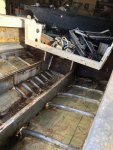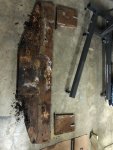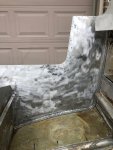Thanks for the info. I’ve cleaned up the metal and made the new transom out of 2 3/4 inch acx plywood. I have US Composites thin epoxy on the way. Gonna coat it twice. Now before I install transom I have more questions.
- Corrosion is deeper than I thought. Is it best to paint to inhibit future corrosion? (I’m talking self etching primer followed by good 2 part epoxy paint)
- Some of the holes are in the aluminum where transom will be installed so I cannot use the bolt/locking nut/5200 method. I would have to use a Wood screw through aluminum w 5200 and into transom. I don’t really like that option with this many holes. So I was also thinking about 5200 between transom and aluminum where I have multiple holes. Another option use a heavier piece of aluminum mounted on outside. A small piece for each group of holes. I was thinking 5200 and 1 long 1/4 bolt/locking nut in the middle of the patch to hold it. So one patch per group of old holes.
- So, how do I avoid corrosion?
Are some of the pits completely through? I recommend putting a light inside then going outside (dark) to look for any pinhole constellations. I found several that I would've otherwise missed.
On the transom wood, epoxy should really be used with glass cloth esp w/ douglas fir PLY. Plywood suffers grain checking and I think its exacerbated by epoxy by itself; glass cloth prevents checking. If you're not using cloth, IMHO you're better off with Varnish or "Old Timer's formula" (use search function). I'm an epoxy/glass guy myself however the OTF definitely has my interest.
I think painting could help if it's applied correctly, doesn't bubble/delam and hold water.
Preventing future corrosion, fill in those pits with JBWELD or marine tex to stop future water pooling. I use phosphoric acid etch + chromate conversion (West Systems 860 kit) to ensure that the pit is clean & that the filler gets a good hold. Careful with this, it's a strong acid and if you don't fully neutralize / remove, it could cause further corrosion. When I did my transom, the z-brace & kneebrace were gone so there weren't any hiding places.
Provide barrier(s) between the aluminum and transom wood (epoxy/glass, varnish, paint).
Ensure good grounding; I believe the that the transom gets increasingly punky b/c of stray currents passing to the true ground at the engine.
For smaller patches, you can use solid rivets to hold an exterior patch in place buttered with 5200. To do this, you'll have to chamfer the interior hole then grind off the bucktail flush with the transom skin before you slide-in the transom wood.
A few guys have mounted an exterior aluminum cladding back-buttered with 5200. if you go this route, you need to be 100% sure that its completely sealed.
Watermann had a creative way to clamp it down. The 5200 along with kneebrace + motor mounts are what hold it in place.
That was a mouthful but you asked alot and you have many options!
















































